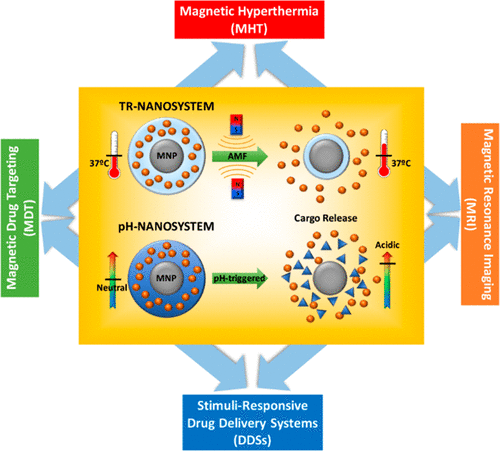当前位置:
X-MOL 学术
›
Acc. Chem. Res.
›
论文详情
Our official English website, www.x-mol.net, welcomes your
feedback! (Note: you will need to create a separate account there.)
Nanosystems Based on Magnetic Nanoparticles and Thermo- or pH-Responsive Polymers: An Update and Future Perspectives
Accounts of Chemical Research ( IF 16.4 ) Pub Date : 2018-05-07 00:00:00 , DOI: 10.1021/acs.accounts.7b00549 Binh T. Mai 1 , Soraia Fernandes 1 , Preethi B. Balakrishnan 1 , Teresa Pellegrino 1
Accounts of Chemical Research ( IF 16.4 ) Pub Date : 2018-05-07 00:00:00 , DOI: 10.1021/acs.accounts.7b00549 Binh T. Mai 1 , Soraia Fernandes 1 , Preethi B. Balakrishnan 1 , Teresa Pellegrino 1
Affiliation

|
Combining hard matter, like inorganic nanocrystals, and soft materials, like polymers, can generate multipurpose materials with a broader range of applications with respect to the individual building blocks. Given their unique properties at the nanoscale, magnetic nanoparticles (MNPs) have drawn a great deal of interest due to their potential use in the biomedical field, targeting several applications such as heat hubs in magnetic hyperthermia (MHT, a heat-damage based therapy), contrast agents in magnetic resonance imaging (MRI), and nanocarriers for targeted drug delivery. At the same time, polymers, with their versatile macromolecular structure, can serve as flexible platforms with regard to constructing advanced functional materials. Advances in the development of novel polymerization techniques has enabled the preparation of a large portfolio of polymers that have intriguing physicochemical properties; in particular, those polymers that can undergo conformational and structural changes in response to their surrounding environmental stimuli. Therefore, merging the unique features of MNPs with polymer responsive properties, such as pH and thermal stimuli activation, enables smart control of polymer properties operated by the MNPs and vice versa at an unprecedented level of sophistication. These magnetic-stimuli-responsive nanosystems will impact the cancer field by combining magnetic hyperthermia with stimuli-dependent controlled drug delivery toward multimodal therapies. In this approach, a malignant tumor may be destroyed by a combination of the synergic effects of thermal energy generated by MNPs and the controlled release of antitumoral agents, activated by means of either heat or pH changes, finally leading to a much more effective cancer treatment than those available today. Also, taking advantage of such a triggered chemotherapy will overcome the notorious drawbacks of classic chemotherapy. Nevertheless, tracking the changes in the magnetic properties of such pH-responsive magnetic nanoparticles, which are provided by changes in relaxation signals of water molecules surrounding the nanoplatform, is a novel approach to the detection of pathological conditions (such as pH-changes at the ischemic and tumor sites). Despite great efforts by chemists to fabricate different featured materials, there have been few successful preclinical studies to date. A clinical translation of magnetic stimuli-responsive systems would require overcoming the actual nanosystem limitations and the joint efforts of an interdisciplinary scientific community.
中文翻译:

基于磁性纳米粒子和热响应或pH响应聚合物的纳米系统:更新和未来的观点。
将硬质物质(如无机纳米晶体)和软质材料(如聚合物)结合在一起,可以生成针对各个构件具有广泛应用范围的多功能材料。鉴于其在纳米级的独特性能,磁性纳米颗粒(MNP)由于其在生物医学领域的潜在用途而引起了广泛的关注,其针对多种应用,例如磁热疗中的热中心(MHT,一种基于热损伤的疗法) ,磁共振成像(MRI)中的造影剂和用于靶向药物递送的纳米载体。同时,具有通用高分子结构的聚合物可以用作构建先进功能材料的灵活平台。新型聚合技术发展的进步使得能够制备大量具有引人入胜的理化性质的聚合物。特别是那些能响应周围环境刺激而发生构象和结构变化的聚合物。因此,将MNP的独特功能与聚合物响应特性(例如pH值和热刺激激活)相结合,就可以智能地控制MNP和MNP所操作的聚合物特性。反之亦然以前所未有的先进水平 这些磁刺激响应性纳米系统将磁热疗与刺激依赖的可控药物向多模式疗法的输送结合起来,将影响癌症领域。在这种方法中,MNPs产生的热能与通过加热或pH改变激活的抗肿瘤剂的控制释放的协同作用可破坏恶性肿瘤,最终导致更有效的癌症治疗比今天有空。同样,利用这种触发的化学疗法将克服经典化学疗法的臭名昭著的缺点。不过,追踪此类对pH敏感的磁性纳米粒子的磁性变化,由围绕纳米平台的水分子的弛豫信号的变化提供的这些方法是一种用于检测病理状况(例如缺血部位和肿瘤部位的pH值变化)的新颖方法。尽管化学家为制造不同的特色材料付出了巨大的努力,但迄今为止,几乎没有成功的临床前研究。磁刺激响应系统的临床翻译将需要克服实际的纳米系统限制和跨学科科学界的共同努力。
更新日期:2018-05-07
中文翻译:

基于磁性纳米粒子和热响应或pH响应聚合物的纳米系统:更新和未来的观点。
将硬质物质(如无机纳米晶体)和软质材料(如聚合物)结合在一起,可以生成针对各个构件具有广泛应用范围的多功能材料。鉴于其在纳米级的独特性能,磁性纳米颗粒(MNP)由于其在生物医学领域的潜在用途而引起了广泛的关注,其针对多种应用,例如磁热疗中的热中心(MHT,一种基于热损伤的疗法) ,磁共振成像(MRI)中的造影剂和用于靶向药物递送的纳米载体。同时,具有通用高分子结构的聚合物可以用作构建先进功能材料的灵活平台。新型聚合技术发展的进步使得能够制备大量具有引人入胜的理化性质的聚合物。特别是那些能响应周围环境刺激而发生构象和结构变化的聚合物。因此,将MNP的独特功能与聚合物响应特性(例如pH值和热刺激激活)相结合,就可以智能地控制MNP和MNP所操作的聚合物特性。反之亦然以前所未有的先进水平 这些磁刺激响应性纳米系统将磁热疗与刺激依赖的可控药物向多模式疗法的输送结合起来,将影响癌症领域。在这种方法中,MNPs产生的热能与通过加热或pH改变激活的抗肿瘤剂的控制释放的协同作用可破坏恶性肿瘤,最终导致更有效的癌症治疗比今天有空。同样,利用这种触发的化学疗法将克服经典化学疗法的臭名昭著的缺点。不过,追踪此类对pH敏感的磁性纳米粒子的磁性变化,由围绕纳米平台的水分子的弛豫信号的变化提供的这些方法是一种用于检测病理状况(例如缺血部位和肿瘤部位的pH值变化)的新颖方法。尽管化学家为制造不同的特色材料付出了巨大的努力,但迄今为止,几乎没有成功的临床前研究。磁刺激响应系统的临床翻译将需要克服实际的纳米系统限制和跨学科科学界的共同努力。











































 京公网安备 11010802027423号
京公网安备 11010802027423号